Russia’s updated nuclear doctrine, which was formally approved by President Vladimir Putin on November 19, would likely never have seen the light of day if not for the U.S. move to allow Ukraine to fire long-range Western missiles into Russia. The West ignored Putin’s dire threats about the consequences of such a decision—and Russia had to respond.
The Kremlin believes the new doctrine will scare the United States into starting to doubt itself. However, it could end up having the opposite effect.
A number of significant changes have been made to the nuclear doctrine since it was previously approved by Putin in 2020. The wording about scenarios that could prompt the use of nuclear weapons has been broadened from a “threat to the very existence of the state” to a “critical threat to sovereignty and/or territorial integrity.” In other words, the threshold for nuclear weapons use has been lowered—and Moscow now considers it possible to use nuclear weapons to protect Russian territory.
It’s no coincidence that the doctrine’s list of military threats has been altered to include “the actions of a potential adversary designed to isolate part of the territory of the Russian Federation.” This immediately brings to mind the Russian exclave of Kaliningrad, which is surrounded by NATO countries that could, theoretically, impose a blockade.
The authors of the changes appear to be trying to signal that the Kremlin will now take extreme steps even if there is a threat to just one of Russia’s regions. That’s unconvincing, however, because their tough words do not correlate with the reality of the battlefield in Ukraine. Not only is Kyiv trying to retake Russian-occupied regions that Moscow has formally annexed and claims as its own, but Ukrainian forces also seized part of Russia’s Kursk region in a 2024 offensive and fighting continues to rage there.
In other words, the battlefield reality makes the new doctrine ambiguous—and gives Moscow’s enemies a lot of freedom to act. This ambiguity will encourage them to push the limits on the ground to discover how many kilometers of Russian territory one actually needs to seize for it to be perceived by Moscow as a “critical threat.”
Other changes to the doctrine include making it clear that Moscow will view aggression from a non-nuclear power with the support of a nuclear power as a joint attack. It will also view an attack by any NATO country as an attack by the whole alliance. In other words, the Kremlin wants the doctrine to scare countries that join alliances or coalitions hostile to Russia. The message is clear: you can’t hide behind nuclear-armed powers.
Yet more changes mean that Russia will now use nuclear deterrence in relation to “states that give over land they control, airspace, and/or seas for the preparation or implementation of aggression against Russia.” This is an obvious reference to Ukraine, which, in Moscow’s thinking, is a pawn of the United States and NATO. While Russian officials have said repeatedly that Russia has no plans to use nuclear weapons against Ukraine, this very option has now been enshrined in a government document. Moscow is once again trying to convince itself—and others—that it is fighting NATO. And the updated doctrine states that any nations that join NATO risk being targeted by a nuclear strike.
It’s also significant that Russia removed a point in the doctrine about complying with arms control agreements (even though Moscow is still a signatory to many such agreements). In theory, this means Russia can now stockpile nuclear warheads and missiles, as well as carry out nuclear tests—while claiming it is all under the aegis of nuclear deterrence.
It’s worth pointing out that in previous iterations, the doctrine stated nuclear weapons were “only a means of deterrence.” In the new version, they removed the word “only.” That means the authors are hinting nuclear weapons could be used on the battlefield.
Finally, amid its struggle with the West, Russia has significantly broadened the list of possible threats that could trigger a nuclear response. In addition to the abovementioned “isolation of a part of Russian territory,” this list now also includes attacks on environmentally dangerous targets (primarily nuclear power plants), the obstruction of access to transport communications essential for life, further NATO expansion, and large-scale military exercises on Russia’s borders. In the past, nuclear threats were made when such scenarios were discussed, but now they have been formalized in an official document.
Taken as a whole, the updated doctrine significantly lowers the threshold for Russia’s use of nuclear weapons. The problem is that the lower this threshold becomes, the harder it is to convince anyone that any such threshold actually exists. After Washington gave Ukraine permission to use U.S. long-range missiles for strikes inside Russia, Putin’s spokesman Dmitry Peskov said the Russian operation in Ukraine had become a standoff with NATO. However, when asked to comment on the first such strikes using U.S. weapons, he avoided the question—simply stating he was confident the Russian military was “in control.”
In other words, the only place Russia’s red lines are actually being tested is on the battlefields of Ukraine. The decision to use nuclear weapons does not depend on what is written in a doctrine, but on one person—Vladimir Putin.




